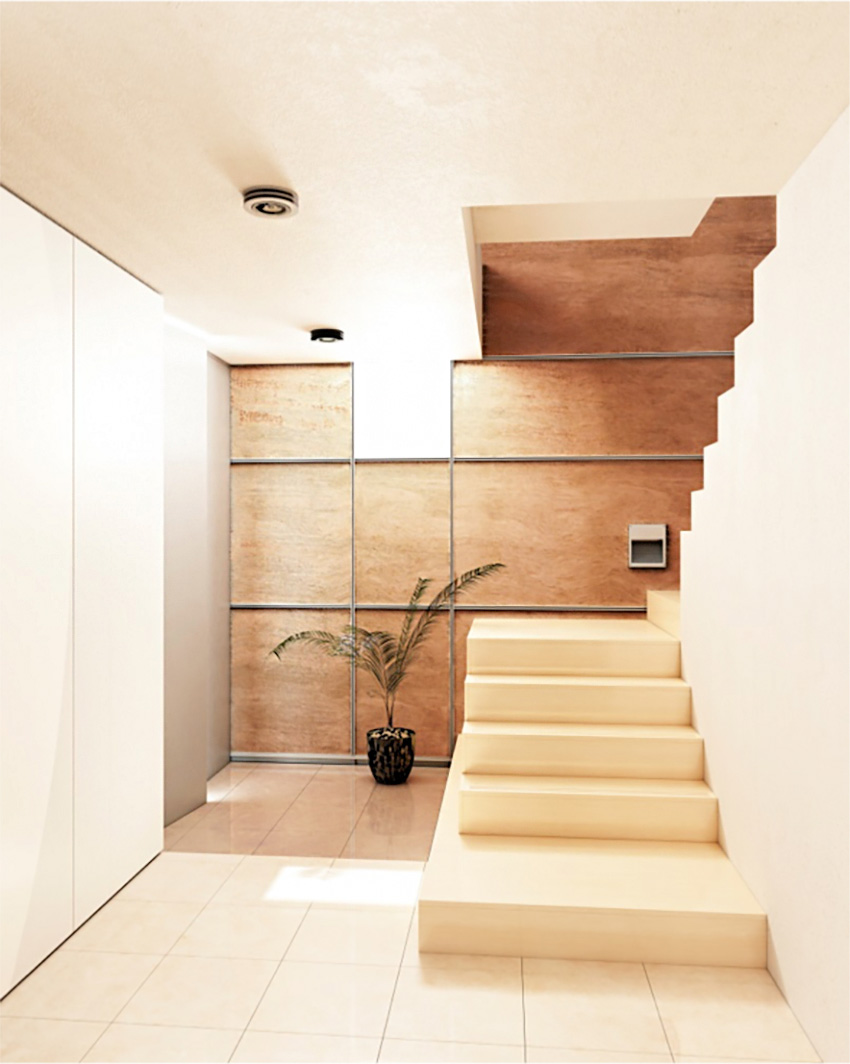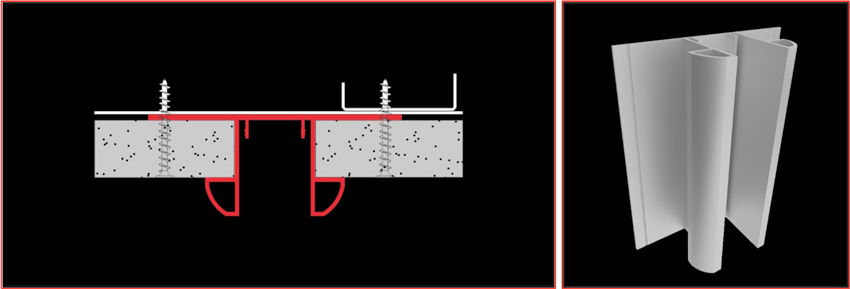This CE Center article is no longer eligible for receiving credits.
This course is part of the Multifamily Housing Academy
While extruded aluminum trim has become a popular material for a building’s exterior—usually as cladding or a facade—it is also increasingly being used indoors to change the face of drywall construction. Extruded aluminum trim provides a high-quality, practical material that can be used to create a featured design and focus in a space. The variety of shapes, forms, and profiles provide designers with a material that has the appearance of fine metal craft, and that can be seamlessly integrated with drywall and panelized surfaces for significantly less than custom metalwork. Moreover, extruded aluminum trim is easy to install. It provides a clean look and works well with modern designs. This section will provide an introductory overview on how and why extruded aluminum trim has become a popular material for interior design.
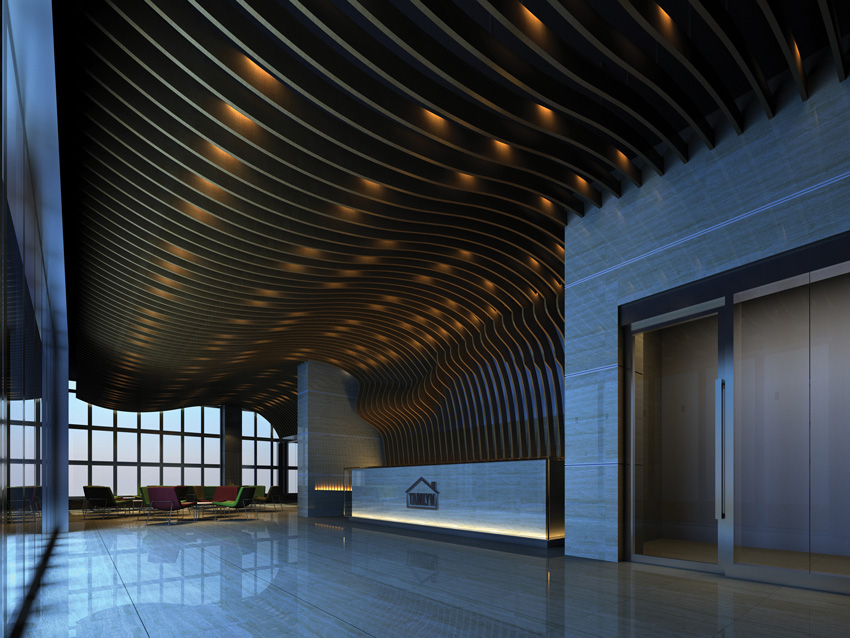
All images courtesy of TAMLYN
Detailing needs to meet an architectural design aesthetic along with meeting durability and sustainability requirements. Extruded aluminum trim interior products can help meet all of these needs.
Details and Architectural Design Aesthetics: Working With Drywall in Multifamily Projects
The practice of using 5/8-inch-thick drywall on metal studs is still considered one of the easiest and most cost-effective ways to define interior spaces. It’s simple to install and also easy to remove. Not surprisingly, it is very popular in projects where designers and architects face the challenges of balancing cost, schedules, and client design goals. Multifamily residential projects are no exception.
When it comes to drywall interiors, multifamily residential projects have a unique set of challenges. In particular, these buildings are subject to much more wear and tear than single-family homes because of frequent occupant turnover. When tenants move in and out of the units, there inevitably will be drywall damage from oversized items that puncture walls, chip corners, damage overhead archways, and otherwise impact the wall surface. Repairing or replacing damaged surfaces can be costly, but leaving them untreated reflects poorly on the overall property. The trick is to design the space with materials that provide modern architectural design aesthetics while accounting for the bumps, bashes, and dents that come with tenants. One area where designers can keep drywall looking good is trim details.
Trim products in general are made of a wide variety of materials, depending on the application. Some of the more commonly used materials include polyvinyl chloride (PVC), wood, rubber, and aluminum. Each material has its advantages and disadvantages, and some trim materials are better for certain applications than others—some are also more costly than others, and so they may not be the best choice for multifamily residential projects. When it comes to cost effectiveness and durability, though, extruded aluminum trim offers a sleek, modern aesthetic that can help multifamily residential projects keep costs down. We’ll discuss those qualities in the next section.
As an interior design material, extruded aluminum trim is considered a top performer for many reasons, but particularly because it is lightweight, inexpensive, and is aesthetically pleasing. This material is versatile and can be used in place of more expensive metals to provide high-quality details on drywall surfaces that both meet a designer’s aesthetic eye and protect drywall with a strong, durable material. Extruded aluminum is also easy to install, which can drastically reduce project times and costs compared to more custom metalwork.
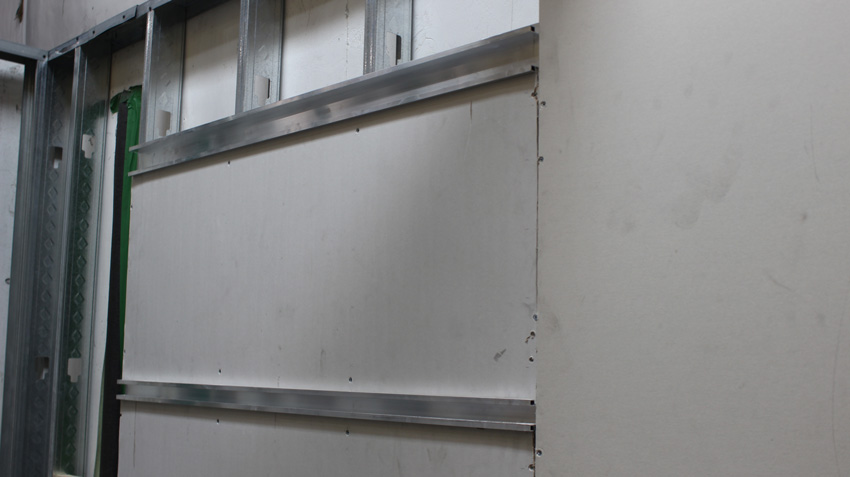
Extruded aluminum trim is lightweight and easy to install, and it greatly enhances both the aesthetic design and performance of a drywall surface.
Modern Design Aesthetics in Multifamily Residential Properties
Before we go any deeper into the performances characteristics of aluminum, it helps to get a better sense of how design trends have changed recently with the two key demographics moving into the multifamily residential market, and how that impacts material choices for drywall interiors.
Baby boomers and millennials have had an impressive impact on multifamily residential properties, not only in terms of the features and amenities, but also in the meaning of the space. Apartments and condominiums are no longer just places to live, but rather they reflect—and sometimes provide—aspects of the occupants’ lifestyle. For example, new building projects may incorporate ways to promote community through shared indoor or outdoor spaces. And building occupants value their individual residential units as a way to highlight their unique style. Many developers are taking on a “resident-first” tactic to project design, and that approach includes elements of a new modern design aesthetic.
One trend that lends itself well to extruded aluminum trim is “mixed-material” design. Millennials in particular tend to be happy to mix older, more rustic materials with sleek, modern looks. Aluminum trim is versatile enough that it can accomplish either look: a clear anodized finish, for example, can keep the natural metal look, or a custom powder coating can add a splash of color into a space of plain drywall.
Also worth considering is dwelling size. Baby boomers are in their downsizing stage of life, and millennials tend to be minimalists, so both demographics benefit from creative techniques that can fit added design features into the structure of the space. Walls that look like they are floating or with deliberate shadow lines built in, for example, can add a unique look to a small apartment or condominium unit. This attention to detail can make a multifamily project stand out from other buildings and help draw tenants. As we will see, the variety of aluminum trim profiles and finishes can play an important role in a design while keeping projects within a fixed income or renter budget.
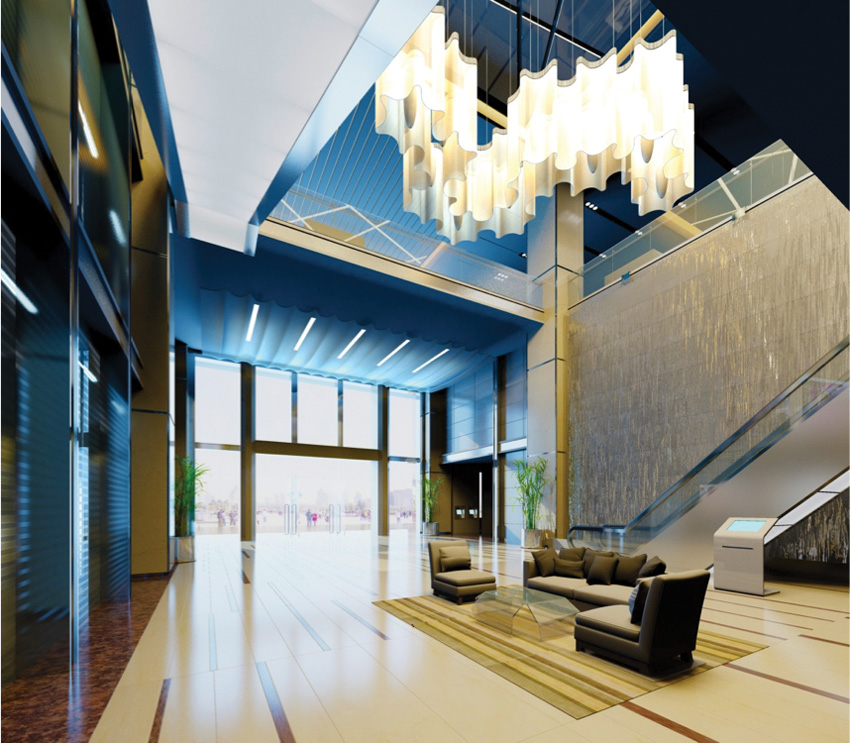
Millennials and baby boomers make up the highest percentage of multifamily residential occupants. Extruded aluminum trim interiors can meet the modern design aesthetics of both generations and everyone in between.
Performance Characteristics and Sustainability Features of Extruded Aluminum
Material performance and sustainability are two top requirements in modern architectural design. This applies to everything from design to materials, and in the case of trim, extruded aluminum is one of the top materials. Not only does aluminum have numerous sustainability features, it also has performance characteristics that make it an affordable choice for both exterior and interior projects. In this section, we will look at what extruded aluminum is and how it is produced to better understand how and why it is an excellent material for architectural purposes.
What is Extruded Aluminum Trim?
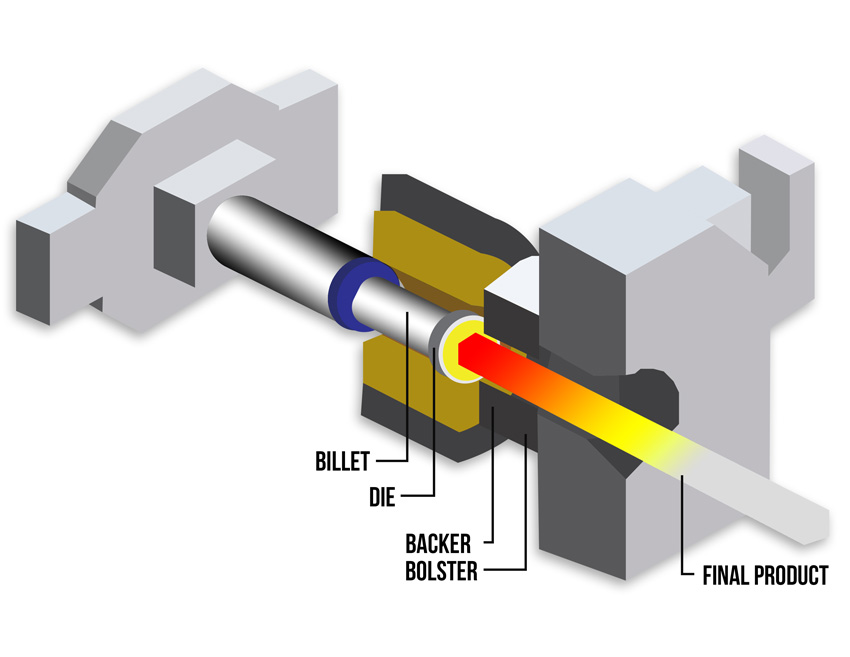
Extruded aluminum is made from alumina, which undergoes smelting and alloying processes that produce solid billets of cast metal. These billets are later pressed through a die to create the desired shape of the extruded trim product.
Aluminum is the most abundant metal in the earth’s crust, although it is always found as a compound, often with bauxite ore, which contains around 30 to 60 percent aluminum oxide (known as alumina). Aluminum can be extracted from the bauxite and then smelted to form the aluminum metal that most people know. Because it is lightweight and durable, works in alloys, and is readily available through new extractions and recycled materials, aluminum is widely used in the transportation, packaging, and construction industries. It resists corrosion and is tolerant of high temperatures, making it ideal for commercial aircraft. It also is non-toxic and has low reactivity to light, water, and oxygen, which is ideal for food packaging as well as construction purposes—from windows and roofing to structural frames, gutters, and external and interior trim.
In order to get these versatile products, alumina first must undergo smelting and alloying. During this process, solid billets of cast metal are created, and these are later extruded through specialized forms in order to create the finished product. Following the extrusion process, the material is finished with anodizing or painting. The finishing process provides a range of colors, textures, and brightness to the aluminum.
Most extruded shapes used for architectural purposes are made from Type 6063–T5 aluminum. This aluminum alloy made with magnesium and silicon is commonly referred to as the “architectural alloy.” It has a very smooth surface that is well suited for anodizing applications. The T5 designation indicates that it has been artificially aged and moderately heat treated.
Characteristics of Extruded Aluminum
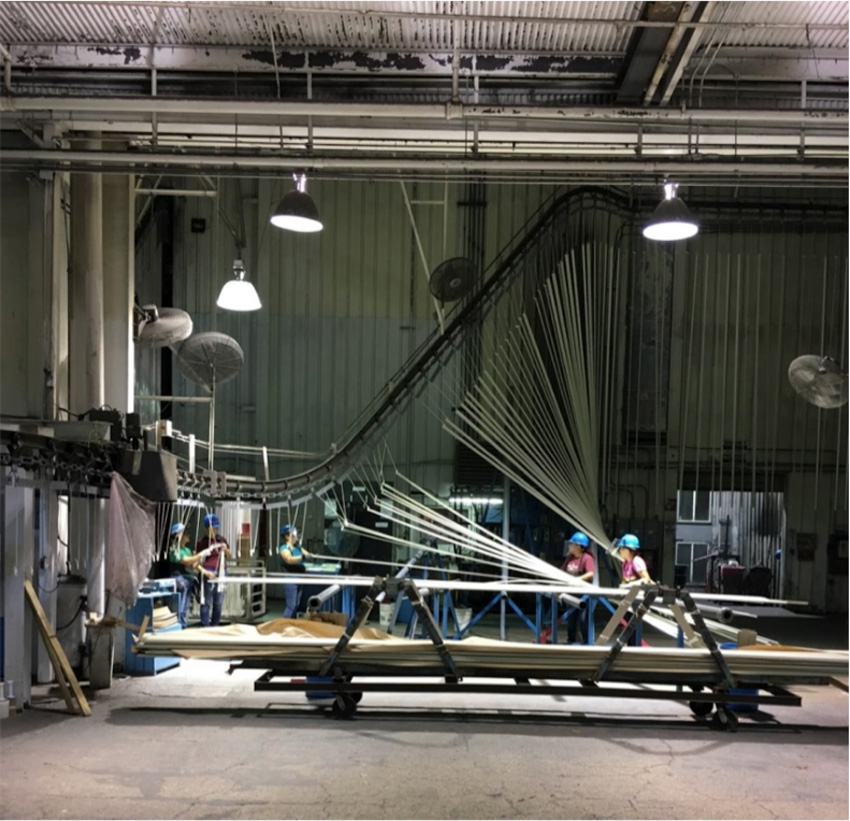
Type 6063–T5 aluminum is used for most extruded shapes. It is an aluminum alloy made with magnesium and silicon, and it has a very smooth surface that is excellent for anodizing. “T5” indicates that the material has been artificially aged and moderately heat-treated.
Extruded aluminum is frequently referred to as the “miracle metal” because it has such an extensive list of favorable properties. These properties make it ideal not just for transportation uses such as commercial aircraft and trucking or food packaging, but also for many different applications in the building industry. Let’s have a closer look at these characteristics that make it such a sought-after material for architectural purposes.
Physical and Health Characteristics
Aluminum’s physical properties and characteristics are at the core of its versatility. As a material, it is strong, durable, and resilient, all while being lightweight. Where some materials are damaged on impact, aluminum can spring back (or be pushed back) to its original form. And, unlike other metals, it doesn’t rust, thanks to its own naturally occurring oxide film.
Moreover, aluminum poses no health or physical hazards. It is fire resistant and noncombustible, and even at extremely high temperatures does not produce toxic fumes. According to the Occupational Safety and Health Administration (OSHA), aluminum trim products are safe enough to be classified as “articles,” which means they do not require published safety data sheets.
When used for interior architectural purposes, aluminum trim can withstand daily use and long-term wear and tear better than most other materials, and that makes it a great option for multifamily residential projects. For example, it’s tough enough to protect corners and bases, and unlike trim made from either PVC or wood, it won’t deteriorate, warp, or be prone to insect damage. Extruded aluminum trim is also lightweight and very easy to install, and those features alone can be a great time and money saver during construction.
Sustainability
As a green building material, aluminum has a lot going for it. Yes, it’s an abundant natural resource, but it’s also recyclable, and most aluminum is made from 75–100 percent post-industrial and post-consumer scrap. With characteristics of strength and high durability, products made from aluminum last a long time before they need to be replaced and recycled. And, as a lightweight material (at least one-third lighter than other metals), it is less expensive to transport than other metals traditionally used for architectural purposes.
All of these attributes mean that aluminum products can help earn LEED v4 certification. Specifically, they can help earn certification in these areas:
- Energy and Atmosphere Credit: Optimize Energy
- Materials and Resources Credit: Building Product Disclosure and Optimization – Environmental Product Declaration (EPD)
- Indoor Environmental Quality Credit: Low-Emitting Materials
Finally, aluminum is the only material that more than pays for the cost of its own collection. As a 100-percent recyclable material, recycled aluminum saves more than 90 percent of the energy costs needed for primary production and generates only 8 percent of the emissions. Once the material is produced, it can be recycled indefinitely. As an interesting side note, approximately 75 percent of all aluminum ever produced is still used today.
Aesthetic and Design Characteristics of Aluminum
Given its physical characteristics, health and safety benefits, and overall sustainability, it’s nice to know that aluminum is aesthetically versatile in terms of the forms and shapes that can be created, as well as the finishes and polishes. Extruded aluminum can be made into highly detailed designs and unique shapes, which then can be finished in a wide variety of textures, colors, and polishes. This versatility means that designers working on interiors easily can match the finishes of doors, windows, frames, and other interior features to create a unified interior design theme.
Profiles and Finishes Available for Extruded Aluminum
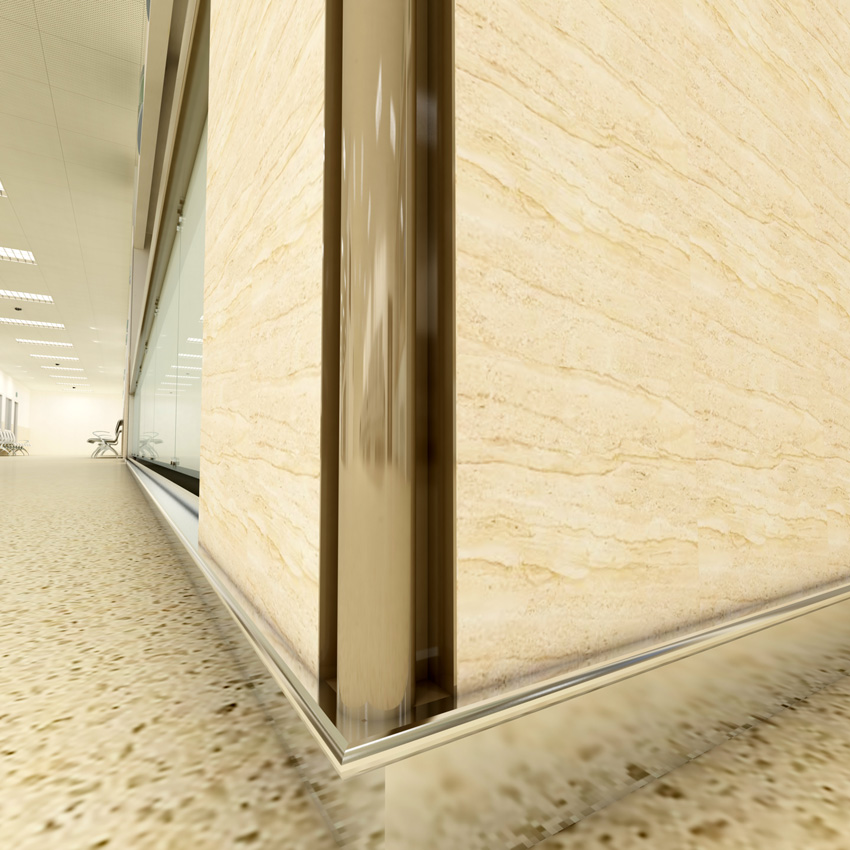
Extruded aluminum trim can be used for many different interior purposes, such as bases and corners, and it can have many different finishes and polishes.
There are many different extruded aluminum trim products available in just about every size, style, and type any project would need. Products such as bases, recessed reveals, corner transitions, and recessed channels that hold three-dimensional inserts of various shapes and sizes are options for designers. Each profile can impact the interior design of a project in subtly different ways, but a common factor is that as extruded aluminum, they are all precisely manufactured under extreme tolerances to produce highly refined results without master craft skilled labor. In addition to the many profiles, products are also available in a variety of metallic finishes—but they also can be primed for custom in-field painting. With so many options, designers can blend the extrusions in with the surface, or use them as a design feature and focus in a room. This section will walk through some of the more common profiles and finishes, and discuss some of the more unique and complex shapes available for extruded aluminum trim.
Baseboard Details
Baseboard details, which are decorative moldings used to cover the joint between the finished wall and the floor, also protect the wall from abrasion and kicks in high-traffic areas. These prominent details are important enough to warrant a quick overview of some of the more common base options. A standard base detail is usually a 3½-inch profile that is installed on top of the drywall. With some applications, quarter round is used as a flooring joint between the flooring and the baseboard to improve the overall aesthetics. While baseboards are still fairly common, some designers question the utility of the traditional baseboard, and that has led to newer, more contemporary options for the design community.
One approach is to simply eliminate the baseboard. Without a baseboard, the wall-to-floor connection creates a simple, minimalistic aesthetic. This option reduces the material used for a project, shortens overall installation time, and eliminates the costs associated with installing and finishing a conventional baseboard. While the look may be clean and minimalist, this approach leaves the wall base susceptible to damage from foot traffic and equipment, so it lends itself more to industrial or commercial applications rather than residential projects.
If a “no-base” approach is used, the joint between the wall and floor should be kept open with a ¾-inch reveal (shadow line) to allow the surfaces to move independently. This reveal can be accomplished by separating the drywall from the floor with a piece of Z-metal. It also requires taping off the lower edge of the drywall. Overall, there is less tolerance for error in the drywall finishing process than with a more traditional baseboard trim.
Another commonly used base is the “flush base.” This base is typically 3½ or 5½ inches, and is recessed so that it is flush against the wall—thus the name. This base style provides a clean, sleek look that works well with a modern interior. Some of the more common materials for a flush base include wood and medium-density fiberboard (MDF). This approach requires considerable planning, work, and care to install, but once it is done, it protects the wall and helps minimize dust collection. Prior to installation, the finished wall surface and base should be fastened to the same underlying substrate to prevent the joint from cracking.
A “reveal base” is a popular technique in modern architectural design. It is used to separate and express the joint between materials to create a shadow line between the two surfaces. This base works especially well when used to separate two different materials, in which case it can create the illusion of the wall floating off the floor. Reveal bases can be custom made of just about any material, but they are typically made of metal or plastic, and they offer designers tremendous flexibility. Key features of a reveal base are a clean edge that is easy to finish, and a wide range of sizes and profiles. Reveal bases also can be painted, giving designers the option of using matching or contrasting colors, as well as incorporating the reveal into the larger design statement of the project, whether through door and window trim, or other features.
Extruded Aluminum Trim Profiles
Given everything we have discussed about the different types of bases available, let’s talk about how extruded aluminum trim fits into the picture. Extruded aluminum bases, for example, can be used to satisfy a wide range of design requirements. These bases are installed horizontally and can be used in different configurations, such as a projecting square or a reveal double flange.
Extruded aluminum is also well suited for reveals. These reveals can be installed in numerous ways, including vertically, horizontally, and diagonally, and they are available in many different styles to meet the needs and requirements of different designers. For example, square reveals, which are strictly decorative, can be used to create shadow lines or to include a break or separation between materials. The effect is an appealing recess that can be installed vertically, horizontally, or diagonally. Square reveals are available in a range of widths from ¼ inch to 4 inches, and are made of either PVC vinyl or aluminum.

Reveal double flanges provide a reveal for visual impact all while protecting the bottom of the wall material.
Channels are another profile option, and they are available in flush square, square tapered, and square angled designs. Flush square channels are a two-part system that includes channels and inserts, which are typically installed vertically and diagonally; however, if the project conditions are approved, the channels can be installed horizontally. These channels have a ridged face that can be used for taping and floating and allows the insert piece to look as if it is freestanding.
Channels are also available in square-tapered and square-angled configurations, which can create a dynamic look when paired with an insert piece, such as a rectangular square, a projecting radiused square, or a blade rectangular round.
Finally, corner trim profiles, usually made with PVC rubber or aluminum, can be used to protect vertical drywall or corner edges, all through a range of design options. Corner trim made from extruded aluminum is considerably more durable and longer lasting than those made from PVC, and there are far more design options available. With aluminum, designers can create beautiful lines, reveals, and shadows to emphasize surfaces and features in a room. The corner trim options available in aluminum are also varied, with square, radiused, round, elliptical, and tapered designs.
Extruded Aluminum Finishes and Polishes
In addition to a variety of aluminum trim profile designs to choose from, architects and designers also have the luxury of having an extensive choice for finishes and polishes. Aluminum trim products are available in a variety of finishes, including ready-to-paint finishes for custom color matching using liquid paints (such as acrylics, alkyds, or polyester, and others) or powder coatings. They are also available in clear and colored anodized finishes.
Anodizing is an electrochemical process that changes a metal’s surface into an anodic oxide finish that is decorative, durable, and corrosion resistant. Aluminum’s physical characteristics make it ideally suited for anodizing treatments. In fact, unfinished aluminum will oxidize naturally when exposed to air, but the artificial oxide film from the anodizing process is thicker, harder, and more durable.
One of the main benefits of anodized aluminum is that, unlike paint or plating, the aluminum oxide is completely integrated with the underlying aluminum substrate. This means that it won’t chip or peel. Another benefit is that the anodized surface has a porous structure that makes a secondary process such as coloring and sealing very easy.
Clear anodized finishes are used to protect the surface and let the natural metallic color of the aluminum be featured. Generally speaking, there is no need to paint anodized trim—in fact, it’s not recommended—but in some cases, it may be necessary. In such cases, designers may first want to see what primed-and-ready-to-paint profiles are provided by the manufacturer. If the desired styles are not available, the moldings must be cleaned with an acid etch solution, rinsed thoroughly, and given time to dry. A primer should be used as a base coat—ideally recommended by the paint manufacturer—followed by the paint.
One of the more popular finishing options for aluminum trim is powder-coated finish. In fact, more than 15 percent of the total industrial finishing market uses powder-coated finishes. The finish is popular not only because it is extremely high quality but also because it has a virtually limitless range of colors.

Powder-coated finishes provide extruded aluminum trim with high-quality finishes in an almost limitless range of colors. The finish is applied to the substrate through electrostatic spray deposition to provide an even finish that is more durable than liquid paint.
Part of powder coating’s popularity also stems from how it is produced and how resilient the final product is. These coatings are based on polymer resin systems, blended with curatives, pigments, leveling agents, flow modifiers, and other additives. The ingredients are melt mixed, cooled, and then ground into a powder. Once the powder is formed, it is applied to the aluminum substrate using a process known as electrostatic spray deposition (ESD). After the powder has been applied, the substrate is heat cured; during this process, the coating chemically reacts to produce long molecular chains that are very strong and do not break down easily. This coating is much more durable than liquid paints. Where liquid paints are prone to eventual diminished quality from exposure to moisture, harsh weather, chemicals, and ultraviolet light, powder-coated aluminum is much stronger. As a more durable finish, powder coating resists scratches, chipping, corrosion, fading, and other wear issues that are known to negatively impact liquid painted surfaces.
Recently, designers such as Wayne Braun, former design director at PDR, have teamed up with extruded aluminum trim manufacturers to create a line of products designed and manufactured to move beyond just enhancing all of the practical aspects of drywall construction and instead transform drywall into a the most impactful element of a well-designed space. In Braun’s case, he has helped design everything from basic aluminum extrusions that include simple reveals and transitions to more complex shapes that include “recessed reveals, corner transitions, edge transitions, and recessed channels that hold three-dimentional inserts of various shapes and sizes. All trim work can be applied to walls and ceilings and floated in flush with a gypsum board surface or installed with panels such as wood, glass, or tile work.”1 With more designers influencing extruded aluminum trim, the opportunities for unique drywall interiors will continue to grow as a trend.
Extruded Aluminum Trim Design Trends to Enhance Drywall Surfaces in Multifamily Residential Projects
In addition to providing a wide range of modern, on-trend aesthetics that highlight cleaner details and distinctive corner profiles, extruded aluminum trim is a cost-effective, convenient, and timesaving alternative to using wood trim or fiber cement boards. All of these aspects can help designers achieve an upscale look for multifamily residential properties even if the project has a tight budget. This section will highlight different extruded aluminum trim design trends that can be used to enhance drywall surfaces in multifamily residential projects.

When used with drywall, extruded aluminum trim can make a big impact. Walls and surfaces can be turned into the feature or the focus and can highlight a well-designed space.
Reveals
One trend that easily can be used in a many different multifamily residential spaces is a minimalist wall with a contrasting recess as a feature. This look can be accomplished with reveals. Square reveals, for example, create a clean, aesthetically pleasing recess that is contrasted by projecting square details. This reveal can be installed vertically, horizontally, or diagonally, and it can be finished with clear anodized or a primed finish that can be powder coated with custom colors to match other design themes of the space.
A nice feature of this reveal—and of many other profiles—is that it can be used with different surfaces, including 5/8-inch drywall, panel installation, and wrapped surface finishes such as fabric or vinyl wall coverings. When used with drywall, the combination of the recess and the finished aluminum allows for a variety of different designs that maintain the sleek, modern look. This design easily can be combined with a wrapped surface, which can add to an apartment or condominium lobby, party room, or other space as a custom feature design that keeps costs low.
Bases
Earlier in the course, we discussed the benefits of traditional baseboards and mentioned that many designers are now questioning the value of those bases, especially in contemporary multifamily residential projects. One solution is to include extruded aluminum trim bases; these profiles protect the wall while providing a modern aesthetic to the spaces where they are used. For example, a reveal double flange creates a recessed base at the bottom of a wall just barely above the floor surface—or at the very top of the wall just below the ceiling. The double-flange profile creates a reveal for striking visual impact while protecting the bottom of the wall material and creating a lower recess. While other profiles can be used in vertical or diagonal designs, the double flange only can be used in horizontal designs. And, as with most other profiles, it comes in standard clear anodized or primed finish. There are anodized color and powder-coating finishes available for custom color matching, so designers have many options to meet their clients’ needs.
Base Shadow Line
Another base profile creates shadow lines with a minimalist approach. This trim makes the wall appear to float just above the floor surface and creates a similar effect at the top of the wall just below the ceiling. The profile can be used vertically or horizontally, and requires ridged facing if taping and floating are needed. As with many of the other profiles, it can be used with wrapped surfaces, and it is available with similar anodized clear or primed finishes. Anodized color and powder-coating finishes are available for projects that require custom color matching.
Corners: Corner Round
Corner profiles can work as a design feature for a space, and they dress up drywall. Corner rounds, for example, have a circular corner for vertical and horizontal drywall (such as fur-down applications) or panel corners. The corner round can be used with fabric or vinyl wrapped surfaces. The profile is made of 6063–T5 aluminum with standard clear anodized or primed finish, and there are anodized color and powder-coating finishes available for custom color matching.
Conclusion
With the multifamily residential housing market booming to provide affordable, modern dwellings for both the baby boomer and millennial generations, building professionals and interior designers have to think out of the box when it comes to interiors. Extruded aluminum trim profiles can be used to achieve modern design goals all while protecting interior drywall surfaces from the wear and tear of rental and high turnover properties such as condominiums.
References
1Braun, Wayne. XtremeInteriors for Architectural Solutions. Unpublished. February 2017.
2Cook, Mary. “7 Ways to Design Residential Developments for Millennials.” Building and Developer. Web. January 2018. <>.
3Lerner, Michele. “The Top Interior Design Trends for Millennials.” The Independent. 19 January 2018. Web. January 2018.
Rebecca A. Pinkus is an independent communication consultant, writer, and editor focusing on the intersection of technology, environment, and human health. She has contributed to more than 35 continuing education courses and publications through Confluence Communications. www.confluencec.com
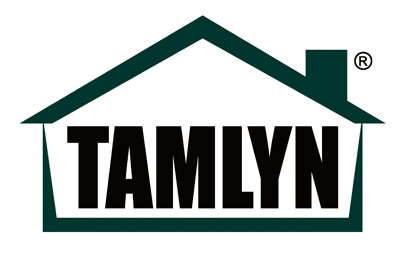
|
TAMLYN is a family-owned company with more than 40 years of involvement in construction materials and building science, and it has taken another step forward to become a leader in the building enclosure field. The company offers quality products, competitive prices, and fast service.
www.tamlyn.com
|










